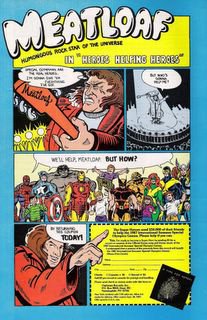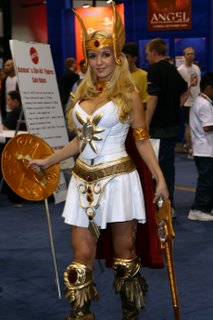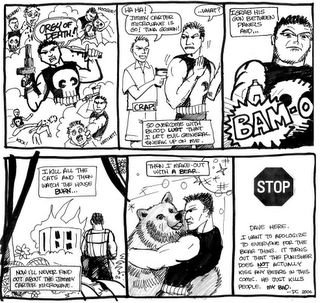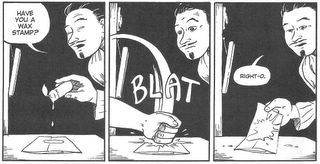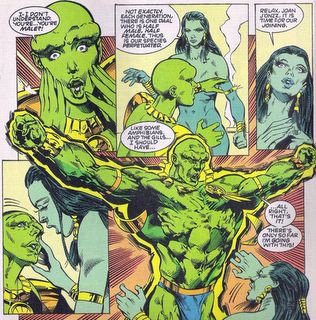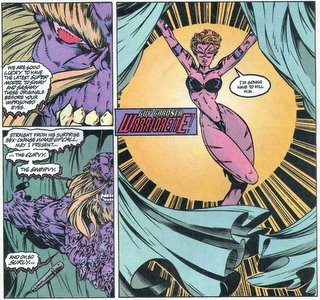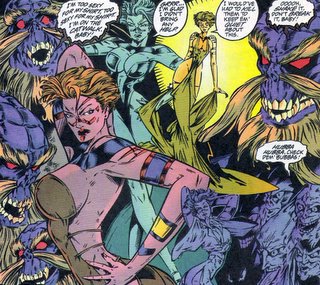
Kraven the Hunter is one of those villains that could fall on either side of the Cool Median, depending on whether you have taste or are stupid. Kraven is an eccentric/psycopathic Russian noble big game hunter who dresses in a Siegfried & Roy outfit and tests his considerable skills by hunting the most challenging game of all: superheroes! He basically looks like a big gay lion tamer. I happen to think Kraven is cool as hell.
If you know anyone who thinks that Kraven the Hunter belongs on the Uncool Side of the Median, punch them in the neck without warning. When/if they have regained the ability to breathe, gently set them in a chair, get them a glass of water, and hand them a copy of the trade paperback Kraven’s Last Hunt. If they still think that Kraven sucks after reading it, curse them and call them a donkey and strike them with the bottom of your shoe.
How can you not like this story? I mean, look at that cover from part two (above)! Kraven standing triumphant over Spider-Man’s grave, screaming, "MORTAL KOMBAAAT!" That’s what comics are all about right there.
Kraven’s Last Hunt is a psychological thriller in which Spider-Man’s old adversary Kraven, the maniac Russian hunter, goes totally batshit-psycho-Capt. Insano and tries to “kill”, then in effect become Spider-Man. Kraven also spends a lot of his time naked in this storyline – dude gets naked more than Paris Hilton. Oh, snap!
Kraven’s Last Hunt, aka "Fearful Symmetry" (and I may be wrong here) came out on a weekly basis in the pages of Amazing Spider-Man, Peter Parker The Spectacular Spider-Man, and Web of Spider-Man in 1987. The creative team of writer JM DeMatteis and artists Mike Zeck and Bob McLeod remained the same for all six-issues, which is as it should be, but I remember thinking it was kind of strange the way the story ping-ponged between Spider titles. One month you’d be reading about Spider-Man chasing Slyde or somebody and the next month, you’d get buck naked Kraven.
DeMatteis’s story is operatic and grandiose and deep and creepy all at the same time, and his approach is effective a good 85% of the time. The rest of the time the script comes across as a little pretentious and overly enamored with symbolism. Like they say, your mileage may vary. I am now officially a blogger because I have used that line: “your mileage may vary.”
What makes Kraven’s Last Hunt a significant comic story is that it was arguably one of the first of its kind: a multi-issue event storyline built around the death of a character that was delivered in a solemn, self-consciously artsy way and was “written for the trade,” i.e., paced to last five or six issues. These days every other issue is “The Death of Speedball, part 7 of 18”, but back in the day, Kraven’s Last Hunt stood out from the crowd.
Penciller Mike Zeck does a fantastic job conveying the rain-drenched mood of the story. I’ve always been a big fan of Zeck’s muscular, well-staged art, and in Kraven’s Last Hunt he shows that he’s equally facile at capturing facial expressions – he really nails Kraven’s raving mania and his more subtle emotions. DeMatteis’s script clearly allowed Zeck room to work – they weren’t afraid to take their time laying out some of the more dramatic sequences. In some comics this kind of cinematic pacing feels like padding, but here it feels right. Check out these panels from part one’s funeral scene, where Kraven and his helpers bury the “dead” Spider-Man:
One criticism I do have of Kraven’s Last Hunt is that on occasion the narrative captions clutter the page and bog down the flow of the story. When you throw dialogue into the mix, you’re asking the reader to keep track of the visual elements on the page, the dialogue balloons and the narrative captions all at the same time. Here’s a beautifully drawn sequence where Kraven is about to shoot Spider-Man that has captions which “compete” with the art:
Perhaps I should mention something about the actual story.
As you might imagine, Spidey eventually returns from the grave, and boy is he pissed off. Kraven shares his triumph with Spider-Man, and then sets Vermin free to kill again. Spider-Man must overcome the trauma of being buried alive in a climactic sewer battle with the beast.
The whole story is very Jungian and heavy on the symbolism. There’s lots of talk of “becoming the Spider” etc. Sometimes the visual metaphors are a little heavy-handed, like this sequence where Vermin gets the drop on Spider-Man, which is intercut with a rat eating a spider:
These are minor quibbles, however. For the most part, Kraven’s Last Hunt hits what it’s aiming for, and even when it doesn’t work for me, I have to admire the skill and craftsmanship involved. The real achievement of DeMatteis’s story is that he transforms Kraven from a second-string villain into a tragic, twistedly noble character who is totally out of step with the world around him. He has divorced himself from the mundane and found honor and meaning in the hunt.
And now that his final hunt is over, Kraven blows his own head off with a rifle:
“They said my mother was insane.”
For me, this haunting, beautifully done scene is the true climax of Kraven’s Last Hunt, and Spider-Man’s fight with Vermin is more of a denouement. When I first read this I was absolutely floored.
Sure, I have some minor beefs with some of the writing, but there are damn few superhero comics that pack the emotional punch of Kraven’s Last Hunt. In the span of six-issues, DeMatteis and Zeck paint a fascinating portrait of madness and misplaced nobility – and then they crush it like you would step on a spider.
Loved it.







